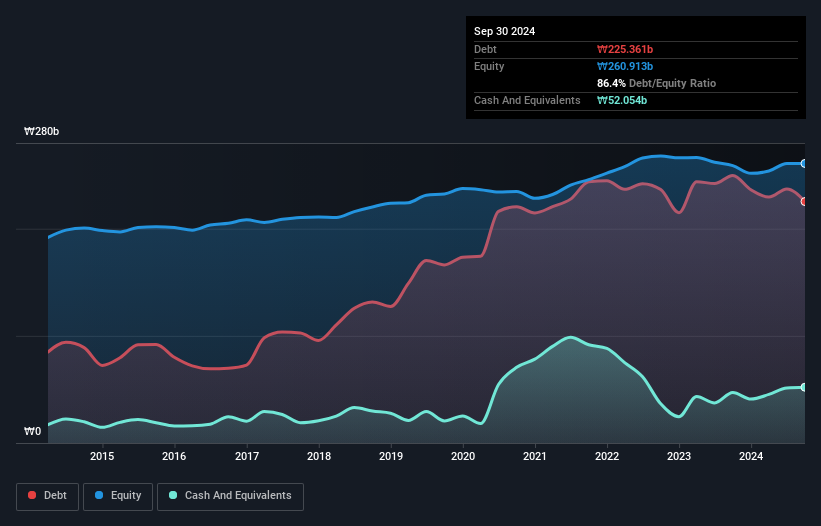- South Korea
- /
- Chemicals
- /
- KOSE:A012610
Kyungin Synthetic (KRX:012610) Has A Somewhat Strained Balance Sheet
Warren Buffett famously said, 'Volatility is far from synonymous with risk.' So it seems the smart money knows that debt - which is usually involved in bankruptcies - is a very important factor, when you assess how risky a company is. We can see that Kyungin Synthetic Co., Ltd. (KRX:012610) does use debt in its business. But should shareholders be worried about its use of debt?
What Risk Does Debt Bring?
Debt is a tool to help businesses grow, but if a business is incapable of paying off its lenders, then it exists at their mercy. If things get really bad, the lenders can take control of the business. While that is not too common, we often do see indebted companies permanently diluting shareholders because lenders force them to raise capital at a distressed price. Of course, the upside of debt is that it often represents cheap capital, especially when it replaces dilution in a company with the ability to reinvest at high rates of return. The first step when considering a company's debt levels is to consider its cash and debt together.
See our latest analysis for Kyungin Synthetic
How Much Debt Does Kyungin Synthetic Carry?
You can click the graphic below for the historical numbers, but it shows that Kyungin Synthetic had ₩225.4b of debt in September 2024, down from ₩249.7b, one year before. However, it does have ₩52.1b in cash offsetting this, leading to net debt of about ₩173.3b.

A Look At Kyungin Synthetic's Liabilities
We can see from the most recent balance sheet that Kyungin Synthetic had liabilities of ₩238.7b falling due within a year, and liabilities of ₩42.0b due beyond that. On the other hand, it had cash of ₩52.1b and ₩79.3b worth of receivables due within a year. So its liabilities outweigh the sum of its cash and (near-term) receivables by ₩149.3b.
When you consider that this deficiency exceeds the company's ₩120.8b market capitalization, you might well be inclined to review the balance sheet intently. In the scenario where the company had to clean up its balance sheet quickly, it seems likely shareholders would suffer extensive dilution.
In order to size up a company's debt relative to its earnings, we calculate its net debt divided by its earnings before interest, tax, depreciation, and amortization (EBITDA) and its earnings before interest and tax (EBIT) divided by its interest expense (its interest cover). This way, we consider both the absolute quantum of the debt, as well as the interest rates paid on it.
Kyungin Synthetic's debt is 3.8 times its EBITDA, and its EBIT cover its interest expense 2.5 times over. This suggests that while the debt levels are significant, we'd stop short of calling them problematic. One redeeming factor for Kyungin Synthetic is that it turned last year's EBIT loss into a gain of ₩21b, over the last twelve months. There's no doubt that we learn most about debt from the balance sheet. But you can't view debt in total isolation; since Kyungin Synthetic will need earnings to service that debt. So when considering debt, it's definitely worth looking at the earnings trend. Click here for an interactive snapshot.
Finally, a business needs free cash flow to pay off debt; accounting profits just don't cut it. So it is important to check how much of its earnings before interest and tax (EBIT) converts to actual free cash flow. Happily for any shareholders, Kyungin Synthetic actually produced more free cash flow than EBIT over the last year. That sort of strong cash conversion gets us as excited as the crowd when the beat drops at a Daft Punk concert.
Our View
On the face of it, Kyungin Synthetic's interest cover left us tentative about the stock, and its level of total liabilities was no more enticing than the one empty restaurant on the busiest night of the year. But at least it's pretty decent at converting EBIT to free cash flow; that's encouraging. Looking at the balance sheet and taking into account all these factors, we do believe that debt is making Kyungin Synthetic stock a bit risky. That's not necessarily a bad thing, but we'd generally feel more comfortable with less leverage. When analysing debt levels, the balance sheet is the obvious place to start. But ultimately, every company can contain risks that exist outside of the balance sheet. For example, we've discovered 3 warning signs for Kyungin Synthetic (2 are potentially serious!) that you should be aware of before investing here.
When all is said and done, sometimes its easier to focus on companies that don't even need debt. Readers can access a list of growth stocks with zero net debt 100% free, right now.
Valuation is complex, but we're here to simplify it.
Discover if Kyungin Synthetic might be undervalued or overvalued with our detailed analysis, featuring fair value estimates, potential risks, dividends, insider trades, and its financial condition.
Access Free AnalysisHave feedback on this article? Concerned about the content? Get in touch with us directly. Alternatively, email editorial-team (at) simplywallst.com.
This article by Simply Wall St is general in nature. We provide commentary based on historical data and analyst forecasts only using an unbiased methodology and our articles are not intended to be financial advice. It does not constitute a recommendation to buy or sell any stock, and does not take account of your objectives, or your financial situation. We aim to bring you long-term focused analysis driven by fundamental data. Note that our analysis may not factor in the latest price-sensitive company announcements or qualitative material. Simply Wall St has no position in any stocks mentioned.
About KOSE:A012610
Kyungin Synthetic
Develops, manufactures, and sells dyes, inks, fine chemicals, and other materials for use in textiles, food, and electronic products in South Korea.
Proven track record with adequate balance sheet.
Market Insights
Community Narratives




